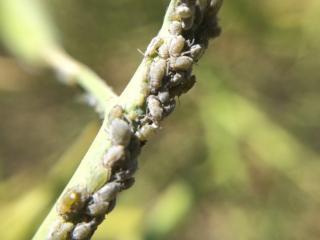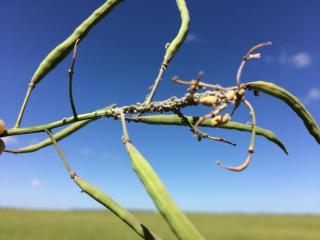Aphids are active in canola crops
- Nunile
- Brookton
- Scaddan
Crop protection officer Bec Swift (DPIRD) has reported finding cabbage aphids on canola in a trial site at Nunile. The canola plants were at the pod ripening stage.
Plant pathologist Kylie Chambers (DPIRD) has found high levels of green peach aphids (GPA) and low levels of cabbage aphids in a canola crop near Brookton.
Development officer King yin Lui (DPIRD) recently reported finding cabbage aphids in pod ripening canola near Scaddan.
Growers and consultants are advised to re-check canola crops for aphids, even if they have been previously sprayed, especially if the crop has experienced frost. They also need to check canola crops for fungal infections and parasitisation in aphids before deciding to invest in an insecticide spray. For more information see the department’s Know what beneficials look like in your crop.
The spray threshold of 20% of plants infested with colonies of cabbage or turnip aphids is not applicable at the advanced podding/grain fill stage because the research for thresholds had focused on flowering crops and effects on flower abortion and reduced seed set. Trial work conducted in Queensland on cabbage aphids suggests that infestations after bolting are not yield limiting, however DPIRD trials have shown that very high numbers of cabbage aphids on pods can cause shrivelled seed during seed filling stage. For more information refer to the GRDC Update paper Insect Pest Management Research Update 2017.
Growers are reminded to abide by the withholding periods on the product labels.
For more information on identifying and managing canola aphids refer to;
- DPIRD’s 2019 PestFax Issue 18 article Cabbage, turnip and bluegreen aphids
- DPIRD’s Aphid management in canola crops page
- DPIRD’s Diagnosing canola aphids page
- DPIRD’s 2017 Protecting WA Crops Issue 3 newsletter Aphids – WA’s insect problem children
- GRDC’s Managing cabbage aphids YouTube video.
For more aphid information contact Dustin Severtson, Development Officer, Northam on +61 (0)8 9690 2160 or Alan Lord, Technical Officer, South Perth on +61 (0)8 9368 3758.
Article authors: Cindy Webster (DPIRD Narrogin) and Dusty Severtson (DPIRD Northam).
Native budworm
Caterpillars
- Northam
- Nunile
- Yealering
- Tincurrin
- Wandering
- Narrogin
- Ongerup
- Esperance
Research officer Christiaan Valentine (DPIRD) reports finding very high numbers of native budworm grubs (over 100 grubs per 10 sweeps) in a Balansa, Prima clover mix pasture at Northam. They were in the buds of both the Balansa clover and Prima gland clover. This pasture is almost finished, but it is likely that the budworm could still do some damage.
Farmers in the Southern Agricultural region should be checking their aerial seeded legume pastures for budworm caterpillars.
Bec Swift (DPIRD) reports finding native budworm caterpillars damaging canola plants at the pod ripening stage in a trial site near Nunile.
A grower at Yealering has reported finding above threshold numbers of budworm in his podding canola.
A grower near Tincurrin is spraying canola and lupin crops after finding above threshold numbers of budworm caterpillars.
Hillary Wittwer (Planfarm) has been finding more than 20 small budworm caterpillars (up to 10 mm) per 10 sweeps in canola crops in the Wandering and Narrogin areas. Crops will be sprayed as the caterpillars are likely to grow larger and cause damage to pods and maturing seed in the coming couple of weeks.
A farmer near Ongerup reports finding 4 to 5 budworm caterpillars per 10 sweeps in a lupin crop. Most of the caterpillars are around 5mm, with some up to 10mm and they are just starting to damage some of the lupin pods.
Monica Field (Farm & General), as well as a farmer, have been finding many crops infested with medium-sized native budworm caterpillars in canola crops in the Esperance region.
Spraying for budworm caterpillars has been occurring in the last week or two in the central agricultural regions where above threshold numbers are being found. High numbers of budworm moths that have been detected in more south westerly locations in recent weeks suggest that budworm grubs are likely to be detectable in sweep nets now or in the coming days.
Some crops in northern and eastern cropping areas are now close to being harvested or swathed and are unlikely to be vulnerable to damage from any remaining native budworm grubs.
Crops still maturing and those in the south western high rainfall locations, especially late sown crops, will still be vulnerable to budworm damage. These crops will need to be checked, using a sweep net at several locations in the crop, to determine if numbers are below spray threshold levels. Monitoring of the crop should be carried out after spraying to confirm that the required level of control has been achieved.
Farmers with native budworm caterpillars in their crops need to be mindful of insecticide withholding periods (WHP) close to harvest and remember that windrowing is classified as harvest.
Native budworm moth trapping surveillance
- Usual automated and manual trapping locations
The larger native budworm moth flights recorded by budworm trappers this week include; Tincurrin (254 moths), Kojonup (90), Cuballing (61) and Kirwan (59).
Results of this week's automated and manual trappings are available at the department’s Native budworm moth numbers 2019.
A mapped view of the native budworm trap captures is available at cesar’s MothTrapVisWA page. Viewers need to select the desired trapping date range.
Detailed information on this pest can be found at the department’s Management and economic thresholds for native budworm.
Pesticide options for the control of native budworm can be found in the department’s Winter/Spring Insecticide Spray Chart 2019.
Previous budworm activity and management information is available at DPIRD’s;
- 2019 PestFax Issue 19 article Native budworm update and likely reasons behind high numbers this season and their presence in cereal crops
- 2019 PestFax Issue 15 article Native budworm and lesser budworm caterpillars are causing damage to crops
- 2019 PestFax Issue 14 article Native budworm moth numbers are high
- 2019 PestFax Issue 12 article Native budworm moth trapping and caterpillar activity.
For more information contact Alan Lord, Technical Officer, South Perth on +61 (0)8 9368 3758 or +61 (0)409 689 468.
Article authors: Alan Lord (DPIRD South Perth) and Dusty Severtson (DPIRD Northam).
Identify what is causing patches in cereal crops to form strategies for the next season
- Brookton
- South Wandering
- Highbury

Plant pathologist Kylie Chambers (DPIRD) reports finding root lesion nematode (RLN) patches in oats in Highbury and in wheat in Brookton.

A consultant has found numerous paddocks with RLN patches this season south of Wandering. The consultant submitted samples to DPIRD for diagnosis (see photo above).
Above ground symptoms of plants infected with root lesion nematodes include stunting, poor growth, plants prone to early wilting and lower leaves turning yellow prematurely and dying back from the tips. Below ground symptoms often include poor root systems with sloughing of the root cortex, fewer lateral roots or root hairs compared to nearby healthy plants. Brown/dark coloured lesions along the roots are also common.
Nematodes are microscopic worm-like creatures that come in many forms and are important to soil biological structure. Plant parasitic nematodes naturally live and feed on the root systems of plants and most plants can tolerate low levels of plant parasitic nematodes without any ill thrift. Unfortunately our monoculture cropping systems in WA often include susceptible crops. This can cause plant parasitic nematode numbers to accumulate to high levels (e.g. >25,000 nematodes/gram of root) and result in significant yield reductions.
Four species of RLN are commonly found in Western Australia: Pratylenchus neglectus, P. quasitereoides, P. thornei and P. penetrans. Other plant parasitic nematodes that can cause yield loss are also present in WA (e.g. cereal cyst nematode, burrowing nematode). Therefore, correct identification of nematode type and species is important because the choice of suitable crop and variety to mitigate future crop damage is dependent on knowing which plant parasitic nematode species are present.
Management measures rely on reducing RLN numbers over a period of at least one season by growing less susceptible crop varieties, resistant break crops or employing fallow periods. With high nematode populations, a break of more than one season may be needed.
Weeds common in WA can also be susceptible to RLN. Control of summer weeds and keeping weeds under control in season in infested paddocks are important management practices.
For more information on nematodes refer to DPIRD’s;
- 2018 Protecting WA Crops Issue 12 Root lesion nematode newsletter
- Diagnosing root lesion nematodes in cereals page
- Root lesion and burrowing nematodes: diagnosis and management page.
Other causes of patches in crops
Patches in cereal crops are not unique to RLN. There are diseases including rhizoctonia, take-all as well as non-disease issues that can cause them. In particular, patches caused by rhizoctonia or RLN are difficult to distinguish from each other without close inspection of the plant roots and require further laboratory tests to identify the primary cause of the issue.
In some cases a combination of diseases are responsible.
Paddocks with a history of continual cropping to cereals are often those that have the worst soil borne disease issues.
Growers that have observed poor patches in their cereal crops this season are urged to diagnose and confirm the issue causing the patches in crops in order to put the right management plan in place for 2020.
How to send plants to be diagnosed
For diagnosis of root disease or nematode problems in-crop, growers and consultants can carefully dig up symptomatic plants from the edge of the patch (not the centre) as well as healthy plants from outside the patches. The department’s YouTube video How to take a plant sample shows the correct method to use. Plants can be sent to the department’s Diagnostic Laboratory Services, Department of Primary Industries and Development, Reply Paid 83377, 3 Baron-Hay Court, South Perth WA 6151.
For more information contact Sarah Collins, Senior Nematologist, South Perth on +61 (0)8 9368 3612, Daniel Hüberli, Plant Pathologist, South Perth on +61 (0)8 9368 3836 or Carla Wilkinson, Research Officer, South Perth on +61 (0)8 9368 3862.
Article authors: Cindy Webster (DPIRD Narrogin) and Sarah Collins (DPIRD South Perth).





